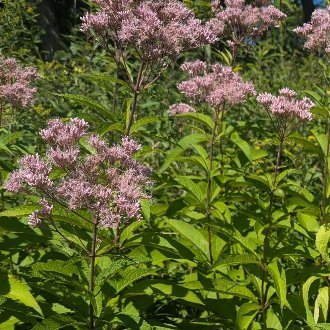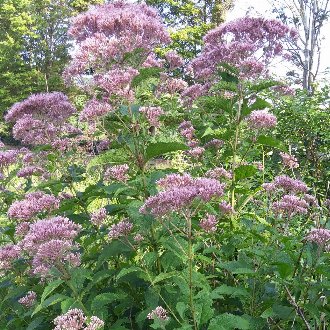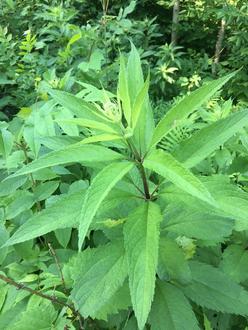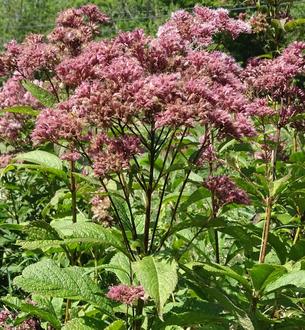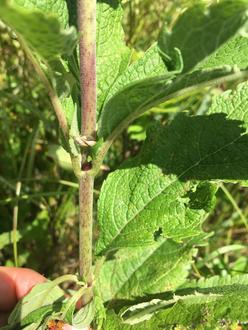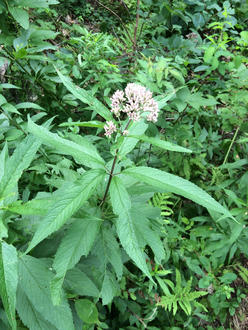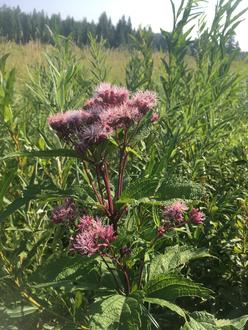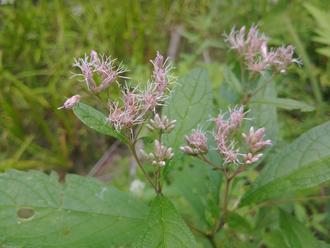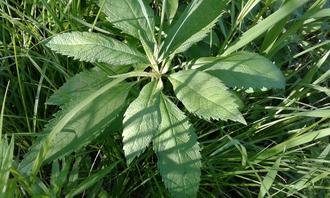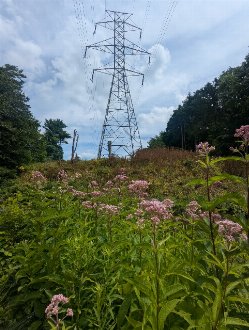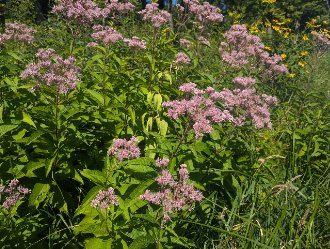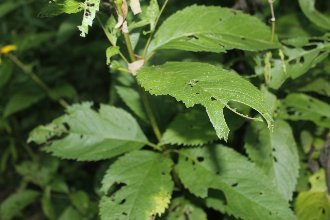Spotted Joe Pye Weed (Eutrochium maculatum (L.) E.E. Lamont)
Also known as spotted joe-pyeweed, spotted joe-pye weed; also classified as Eupatoriadelphus maculatus, Eupatorium maculatum, Eupatorium purpureum var. maculatum.
↑Summary
A perennial of sunny, calcium-rich wetlands, ranging the farthest north of its genus.
↑Description & Identification
A perennial, often found in large colonies with multiple stems, typically to 4-5 feet in height but may reach 6 feet.
Stem usually green with visible purple spots, or purple with darker purple spots that require closer inspection to see. Stems sometimes more purple above each node but purple does not usually extend below the node or onto petioles (stems of each leaf.) Spotting often extends onto petioles and even along central vein of leaves. Stem is usually solid; if hollow it only has a narrow central cavity.
Leaves usually in whorls of 4-5. Leaves have sharply serrated margins, and a textured appearance with prominently-depressed veins, and usually lack a triple-veined appearance, with numerous small side-veins but none dominant.
Inflorescence flat-topped, especially relative to other Eutrochium sp., usually 9-22 florets per head, a grayish purple color, more washed-out than most pink or purple flowers, including other Eutrochium sp.
↑Similar Plants
↑Habitat
Found in a variety of sunny wetlands, including marshes, swamps, fens, floodplains, wet meadows, shores of lakes or rivers, thickets, and moist openings in forests. Primarily found on mineral-rich soils that are consistently moist, most often alluvial soils and soils with sandy to loamy texture. Although it is usually found on soils with a well-drained texture, it tolerates saturated or waterlogged soil and significant flooding. Its preference for calcium-rich conditions makes it favor spring-fed wetlands as groundwater is often calcium-rich.
This plant inhabits a broader range of habitats in the interior and northern parts of its range; at the southern and western limits of its range it is uncommon and strictly limited to calcareous wetlands, usually intact natural areas. In the heart of its range, it can also found in more disturbed habitats, slightly drier conditions, and anthropogenic habitats including roadside ditches and abandoned fields. Along the east coast, where wetlands are more likely to be acidic and calcium-poor, it is mostly replaced by coastal plain Joe Pye weed (Eutrochium dubium), which favors acidic wetlands.
↑Life Cycle
This species is a rhizomatous perennial.
Plants sprouted from seed do not usually reach their full height, and do not always bloom in their first year, but may produce small blooms if conditions are favorable.
Plants bloom from mid-to-late summer into early fall, usually starting in August, sometimes in July, and continuing into September, sometimes October. Seeds ripen in fall and are distributed by wind. Seeds germinate the following spring, following a period of cold dormancy.
We could not find information on the typical conditions for seed germination, or seedling establishment or survival in the wild. Some studies have found the presence of seeds in the seedbank but we could not verify whether these seeds were found to be viable, and if so, how long it persists in the seedbank and whether seedbanking is an important means of establishment.
Plants growing in favorable conditions reproduce vegetatively by rhizomes, with a single plant establishing many stems. We could not find documentation of this species' typical lifespan in the wild, but due to the more stable nature of some of the habitats in which it occurs, it likely has a longer lifespan than some of the other Eutrochium species that favor more transient habitats dependent on disturbance.
↑Faunal Associations
The flowers attract a variety of pollinators, including honeybees, bumblebees, long-horned bees (Melissodes spp.), leafcutter bees (Megachile spp.), bee flies (Bombyliidae), butterflies, skippers, and moths, all of which primarily seek nectar.
Numerous insects also eat the various parts of the plant, including the leaf beetles Exema dispar, Ophraella notata, and Sumitrosis inaequalis. The aphid Aphis vernoniae eats the sap. The larvae of several moths eat this and other Eutrochium species, usually along with other related plants of the Eupatoriae tribe: the three-lined flower moth (Schinia trifascia) eats the florets, the eupatorium borer moth (Carmenta bassiformis) eats the roots, the ruby tiger moth (Phragmatobia fuliginosa) eats the leaves. The polyphagous common eupithecia (Eupithecia miserulata) also eats the florets.
The seeds are eaten by birds.
The foliage is occasionally browsed by mammals, including deer and rabbits, but usually only in small quantities due to its toxicity.
↑Uses
This plant is widely used in landscaping, especially in native plant gardens, and is probably the most widely-planted Joe Pye (Eutrochium sp.) in landscaping. It is valued for its support of insects, particularly attracting butterflies, for its attractive foliage and distinctive stems, and for its showy flowers that are a unique shade of purple exhibited by few other plants. In the garden, it can tolerate slightly drier and lower-calcium conditions than it would occur in naturally, but it is not drought-tolerant and is best-suited to wet sites.
It can be grown as a garden plant well south of its native range, but we recommend against doing so because in these regions, it will not spread from gardens into the wild. It is better to choose locally-native Eutrochium species, growing plants derived from local wild populations, so that the landscaping can be a seed source to strengthen and support local populations. When growing this plant outside its native range, it supports insects but it does not support local Eutrochium populations and thus its benefits are greatly reduced. South of this species' range, trumpetweed (Eutrochium fistulosum), sweetscented Joe Pye weed (Eutrochium purpureum) (in drier, shadier conditions), or coastal plain Joe Pye weed (Eutrochium dubium) (in acidic soils) are better choices.
Several cultivars exist, including 'Gateway' which is actually a cultivar of this species but is often mislabeled as E. purpureum or sometimes E. fistulosum.
This species can also be used, usually planted together with other species, to fill detention basins or at the margins of retention basins, where it is valued for its ability to survive temporary flooding. Some projects have also seeded it into wet roadside ditches. Such use makes sense in the heart of its range but not at the edges or outside its range where this plant rarely survives in disturbed habitats.
It has been historically used for medicinal purposes but it contains a variety of toxins and is not generally considered safe.
↑Related Plants
This species is closely related to the four other Eutrochium species, and overlaps with all of them in range. Where their ranges overlap, it can hybridize in the wild with sweetscented joe pye weed (Eutrochium purpureum) and likely with the other three species although we were not able to verify the existence of such hybrids.
↑Links & External Resources
• Eutrochium maculatum (Spotted Joe-Pye Weed) | Illinois Wildflowers (About This Site)
• Eutrochium maculatum (Spotted Joe Pye Weed) | USDA PLANTS Database (About This Site)
• Eutrochium maculatum | Go Botany (About This Site)
• Spotted Joe-Pye Weed | iNaturalist (About This Site)
• Eutrochium maculatum (Joe Pye Weed) | Missouri Botanical Garden Plant Finder (About This Site)
• Eutrochium maculatum | Biota of North America Project (BONAP) (About This Site)
• Eutrochium maculatum | Flora of North America (About This Site)
• Eutrochium maculatum | Missouri Plants (About This Site)
• Spotted Joe Pye Weed | Maryland Biodiversity Project (About This Site)
• Eutrochium maculatum (Spotted Joe-pye Weed) | Minnesota Wildflowers (About This Site)
• Eutrochium maculatum (L.) E.E. Lamont var. maculatum (Spotted Joe-pye-weed) | Digital Atlas of the Virginia Flora (About This Site)



